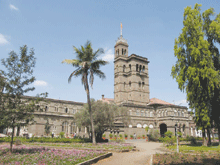 Identified by the University Grants Commission (UGC) as one of the country’s top five universities with potential for excellence, the University of Pune (UoP) launched its diamond jubilee (60 years) celebrations on February 10. Perhaps the largest university in India, UoP has 520 colleges and 300 recognised institutes spread across Pune, Ahmednagar and Nashik districts, affiliated with it. Together, these institutions cater to a student population of 6.5 lakh, including 14,000 students from a dozen countries around the world. The varsity’s diamond jubilee celebrations were inaugurated on February 10 by Rajesh Tope, the state’s minister for higher and technical education.
Identified by the University Grants Commission (UGC) as one of the country’s top five universities with potential for excellence, the University of Pune (UoP) launched its diamond jubilee (60 years) celebrations on February 10. Perhaps the largest university in India, UoP has 520 colleges and 300 recognised institutes spread across Pune, Ahmednagar and Nashik districts, affiliated with it. Together, these institutions cater to a student population of 6.5 lakh, including 14,000 students from a dozen countries around the world. The varsity’s diamond jubilee celebrations were inaugurated on February 10 by Rajesh Tope, the state’s minister for higher and technical education.
Speaking on the occasion, Tope expressed enthusiasm for expanding higher education capacity in Maharashtra (pop. 98 million) — India’s most industrialised state. “A think-tank of experts, which will guide the state government to secure a high percentage of the Rs.12,100 crore budgeted by the Union HRD ministry for the Eleventh Plan period (2007-12), has been constituted. Moreover a concept note on the setting up of the Maharashtra State Technology University is ready and due for discussion by the state cabinet,” said Tope who added that an independent university of fine arts, is also imminent.
Conceptualised on the lines of Anna University in Tamil Nadu, the technology university is expected to effectively regulate the growing number of technical institutions offering degree programmes in engineering, pharmacy, management studies, hotel management and catering technology. Currently Maharashtra hosts 225 engineering colleges and an almost equal number of business management institutions.
Speaking at the UoP diamond jubilee celebrations, Nashik-based education baron Balasaheb Wagh, who heads the Association of Managements of Unaided Engineering Colleges in the state, highlighted that Maharashtra is way behind the southern states in terms of engineering student intake per year. “Against the intake of 62,000 in Maharashtra, states such as Andhra Pradesh and Tamil Nadu admit 150,000 and 135,000 students respectively every year,” he said.
According to Tope, increased enrollment in higher education can be achieved by multiplying the number of colleges and encouraging engineering colleges and polytechnics to run double shifts. Similarly, he advised focus on provision of employment and life-skills oriented courses through industry-academia interaction to bridge the skilled manpower gap of industry.
To round up the UoP diamond jubilee celebrations, in his presidential speech, former Union cabinet secretary B.G. Deshmukh urged UoP to focus on one or two disciplines and work towards emerging at the “top of the world”.
Although essentially an in-house celebration, UoP’s diamond jubilee festivities seem to have inspired educationists in Maharashtra to develop the state’s education infrastructure — particularly in higher education — to levels commensurate to its status as India’s most industrialised state, accounting for almost 25 percent of the country’s industrial output.
Huned Contractor (Pune)
Malaise apprehension
The murder of Mukeem Khan, a class XII student of Mumbai’s well-known Rizvi College, on February 13 allegedly by two of his closest friends who turned against him to demand a ransom from his family, has shocked educationists in India’s commercial capital. Within the city’s academic circles, there’s growing apprehension that a malaise of greed, anger and envy is spreading among Mumbai’s college students.
Says Rizvi College principal Dr. S.G.A. Zaidi: “I’m devastated and saddened about such news relating to my students. Unfortunately I have no control over what our students do beyond college gates. My request to parents is to keep a track of their children’s whereabouts and activities.”
Mukeem’s murder by his bosom pals who suddenly turned on him to make a quick buck has evoked memories of a similar murder driven by treachery and greed. On August 18, 2007, Adnan Patrawala, the 16-year-old son of a businessman, was kidnapped by three of his friends, whom he had reportedly met on a social networking site. The trio demanded a ransom of Rs.2 crore for his release. But when news of the kidnap was broadcast on national television, they panicked, killed him and dumped his body in the marshes of Navi Mumbai.
“These are troubled times when money is power and relationships are superficial. Fun, wealth and self-indulgence are the priorities of a growing percentage of middle class youth. The anonymity of cities and a failing criminal justice system prompt such crimes. The frequency of such incidents is much higher now and the age profiles of psychopaths is getting younger,” says Dr. Harish Shetty, a well-known psychiatrist in Mumbai.
Student counsellors and academics in Mumbai are particularly alarmed by the widely publicised data of the National Crime Record Bureau. According to the bureau, 44 percent of criminals arrested countrywide are in the age group 10-44 years. Behavioural scientists tend to relate rising criminality with greater consumption of alcohol. According to a recent Assocham study conducted in Chennai, Mumbai and Hyderabad, among other cities, alcohol consumption of students between 19-26 years of age has increased by 60 percent during the past four years.
“School and college managements need to urgently introduce lifestyle study and counselling programmes highlighting the dangers of alcohol and drug abuse. Also ‘compassion’ as a philosophy needs to be emphasised. The reluctance of teenagers to report alcohol and substance abuse and high-risk behaviour of their friends also needs to be addressed. High risk children and youth need early intervention,” warns Dr. Shetty.
It’s a timely warning that educationists and parents need to heed to save themselves deep grief.
Harshikaa Udasi (Mumbai)